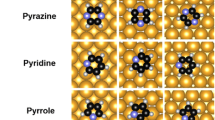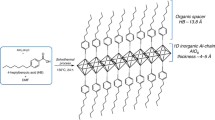Abstract
Metal-organic structures are controllably prepared by tuning molecular size, supported substrates, and different kinds of metals. They are characterized by ultra-high vacuum low-temperature scanning tunnelling microscopy and Density functional theory calculations. The relatively larger size of all-trans-retinoic acid (ReA) compared to (2E,4E)-3-methyl-5-(2,6,6-trimethylcyclohex-1-enyl)penta-2,4-dienoic acid (DiA) leads to a bigger gap between neighboring ReA in a tetramer and allows for insertion of molecules, forming high density patterns. ReA forms various structures with different ratios (4:0, 3:1, 2:2) of the two chiral enantiomers on the less reactive Au(111) other than Ag(111). Unlike transition metals, electrostatic attraction between molecules and alkali metals is the origin of the formation of large quartet islands.





Similar content being viewed by others
References
P. García-García, M. Müller, and A. Corma (2014). Chem. Sci. 5, 2979.
B. O. Stefan Leininger and Peter J. Stang (2000). Chem. Rev. 100, 853–908.
T. R. Cook, Y. R. Zheng, and P. J. Stang (2013). Chem. Rev. 113, 734–777.
B. Moulton and M. J. Zaworotko (2001). Chem. Rev. 101, 1629–1658.
M. El Garah, A. Ciesielski, N. Marets, V. Bulach, M. W. Hosseini, and P. Samori (2014). Chem. Commun. 50, 12250–12253.
Y.-F. Y. En-Qing Gao, Shi-Qiang Bai, Zheng He, and C.-H. Yan (2004). J. Am. Chem. Soc. 126, 1419–1429.
T. Suzuki, T. Lutz, D. Payer, N. Lin, S. L. Tait, G. Costantini, and K. Kern (2009). Phys. Chem. Chem. Phys. 11, 6498–6504.
P. Larpent, A. Jouaiti, N. Kyritsakas, and M. W. Hosseini (2019). Chem. Commun. 55, 91–94.
P. Knecht, N. Suryadevara, B. Zhang, J. Reichert, M. Ruben, J. V. Barth, S. Klyatskaya, and A. C. Papageorgiou (2018). Chem. Commun. 54, 10072–10075.
X. Zhang, N. Li, L. Liu, G. Gu, C. Li, H. Tang, L. Peng, S. Hou, and Y. Wang (2016). Chem. Commun. 52, 10578–10581.
T. Lin, G. Kuang, X. S. Shang, P. N. Liu, and N. Lin (2014). Chem. Commun. 50, 15327–15329.
T. A. Pham, F. Song, M. N. Alberti, M. T. Nguyen, N. Trapp, C. Thilgen, F. Diederich, and M. Stohr (2015). Chem. Commun. 51, 14473–14476.
J. Kuliga, L. Zhang, M. Lepper, D. Lungerich, H. Holzel, N. Jux, H. P. Steinruck, and H. Marbach (2018). Phys. Chem. Chem. Phys. 20, 25062–25068.
D. Hotger, M. Etzkorn, C. Morchutt, B. Wurster, J. Dreiser, S. Stepanow, D. Grumelli, R. Gutzler, and K. Kern (2019). Phys. Chem. Chem. Phys. 21, 2587–2594.
H. Kong, L. Wang, Q. Tan, C. Zhang, Q. Sun, and W. Xu (2014). Chem. Commun. 50, 3242–3244.
C. Wang, Q. Fan, S. Hu, H. Ju, X. Feng, Y. Han, H. Pan, J. Zhu, and J. M. Gottfried (2014). Chem. Commun. 50, 8291–8294.
G. Kresse and D. Joubert (1999). Phys. Rev. B. 59, 1758–1776.
J. P. Perdew, K. Burke, and M. Ernzerhof (1996). Phys. Rev. Lett. 77, 3865–3869.
C. Yuan, N. Xue, X. Zhang, Y. Zhang, N. Li, Q. Xue, T. Wu, S. Hou, and Y. Wang (2019). Chem. Commun. 55, 5427–5430.
S. Karan, Y. Wang, R. Robles, N. Lorente, and R. Berndt (2013). J. Am. Chem. Soc. 135, 14004–14007.
C. Li, N. Li, L. Liu, Y. Zhang, C. Yuan, L. Peng, S. Hou, and Y. Wang (2017). Chem. Commun. 53, 2252–2255.
Acknowledgements
This work is supported by the Ministry of Science and Technology (2018YFA0306003,2017YFA0205003), National Natural Science Foundation of China (21972002,21902003) and China Postdoctoral Science Foundation (CPSF) (2019T120010, 2019M660296). DFT calculations are carried out on TianHe-1A at National Supercomputer Center in Tianjin and supported by High-performance Computing Platform of Peking University.
Author information
Authors and Affiliations
Corresponding authors
Ethics declarations
Conflict of interest
The authors declare that they have no conflict of interest.
Additional information
Publisher's Note
Springer Nature remains neutral with regard to jurisdictional claims in published maps and institutional affiliations.
Rights and permissions
About this article
Cite this article
Yuan, C., Xue, N., Zhang, Y. et al. Controlling Metal-Organic Structure by Tuning Molecular Size, Supported Substrate, and Type of Metal. J Clust Sci 32, 327–330 (2021). https://doi.org/10.1007/s10876-020-01791-x
Received:
Published:
Issue Date:
DOI: https://doi.org/10.1007/s10876-020-01791-x




